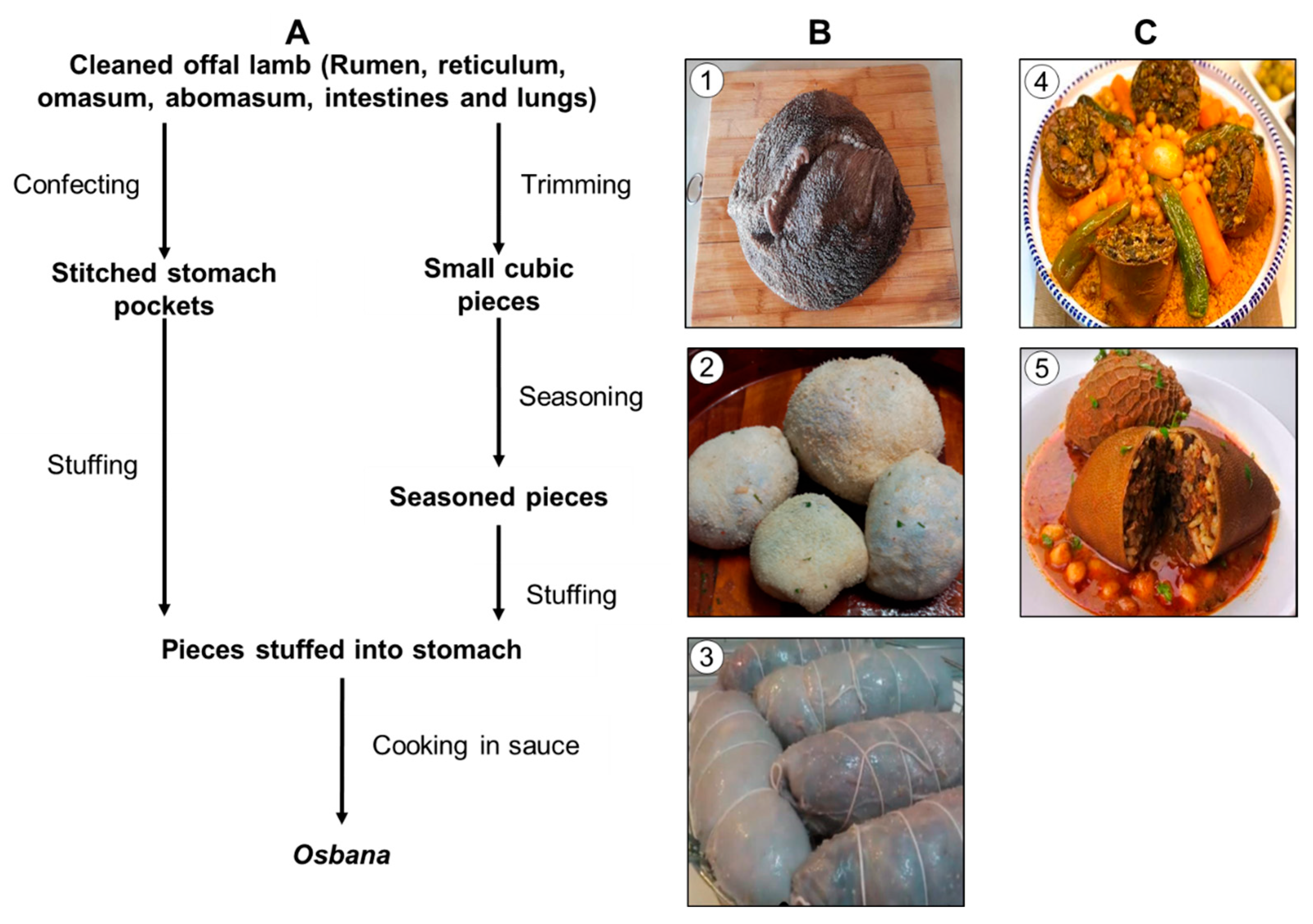Culinary Preparation and Consumption Habits of Osbana: An Algerian Cooked Sausage-like Traditional Meat Product †
Abstract
1. Introduction
2. Materials and Methods
3. Results and Discussion
4. Conclusions
Author Contributions
Funding
Institutional Review Board Statement
Informed Consent Statement
Data Availability Statement
Acknowledgments
Conflicts of Interest
References
- Halagarda, M.; Wójciak, K.M. Health and safety aspects of traditional European meat products. A review. Meat Sci. 2022, 184, 108623. [Google Scholar] [CrossRef] [PubMed]
- Gagaoua, M.; Boudechicha, H.-R. Ethnic meat products of the North African and Mediterranean countries: An overview. J. Ethn. Foods 2018, 5, 83–98. [Google Scholar] [CrossRef]
- Santos, N.M.; Costa, R.G.; Madruga, M.S.; Medeiros, A.N.; Albuquerque, C.L.C.; Queiroga, R.C.R.E. Constitution and Compo-sition Chemistry of the Precooked Goat like Buchada Produced in the State of Paraíba, Brazil. Braz. Arch. Biol. Technol. 2008, 51, 793–798. [Google Scholar] [CrossRef]
- Latoch, A.; Stasiak, D.M.; Siczek, P. Edible Offal as a Valuable Source of Nutrients in the Diet—A Review. Nutrients 2024, 16, 1609. [Google Scholar] [CrossRef] [PubMed]
- Ockerman, H.W.; Basu, L.; Toldrá, F. Chapter 22-Edible By-products. In Lawrie´s Meat Science, 8th ed.; Toldrá, F., Ed.; Woodhead Publishing: Duxford, UK, 2017; pp. 679–696. [Google Scholar]
- Chemache, L.; Kehal, F.; Namoune, H.; Chaalal, M.; Gagaoua, M. Couscous: Ethnic making and consumption patterns in the Northeast of Algeria. J. Ethn. Foods 2018, 5, 211–219. [Google Scholar] [CrossRef]

Disclaimer/Publisher’s Note: The statements, opinions and data contained in all publications are solely those of the individual author(s) and contributor(s) and not of MDPI and/or the editor(s). MDPI and/or the editor(s) disclaim responsibility for any injury to people or property resulting from any ideas, methods, instructions or products referred to in the content. |
© 2025 by the authors. Licensee MDPI, Basel, Switzerland. This article is an open access article distributed under the terms and conditions of the Creative Commons Attribution (CC BY) license (https://creativecommons.org/licenses/by/4.0/).
Share and Cite
Achou, L.; Touidjini, O.; Tolba, C.; Gagaoua, M. Culinary Preparation and Consumption Habits of Osbana: An Algerian Cooked Sausage-like Traditional Meat Product. Biol. Life Sci. Forum 2025, 49, 12. https://doi.org/10.3390/blsf2025049012
Achou L, Touidjini O, Tolba C, Gagaoua M. Culinary Preparation and Consumption Habits of Osbana: An Algerian Cooked Sausage-like Traditional Meat Product. Biology and Life Sciences Forum. 2025; 49(1):12. https://doi.org/10.3390/blsf2025049012
Chicago/Turabian StyleAchou, Lydia, Oumeïma Touidjini, Chaima Tolba, and Mohammed Gagaoua. 2025. "Culinary Preparation and Consumption Habits of Osbana: An Algerian Cooked Sausage-like Traditional Meat Product" Biology and Life Sciences Forum 49, no. 1: 12. https://doi.org/10.3390/blsf2025049012
APA StyleAchou, L., Touidjini, O., Tolba, C., & Gagaoua, M. (2025). Culinary Preparation and Consumption Habits of Osbana: An Algerian Cooked Sausage-like Traditional Meat Product. Biology and Life Sciences Forum, 49(1), 12. https://doi.org/10.3390/blsf2025049012






